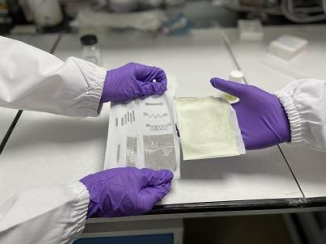2022-06-07 スウェーデン王国・カロリンスカ研究所(KI)

・ KI が、果物に残留する農薬を数分で検出する安価なナノセンサーを開発。
・ 新ナノセンサーは、1970 年代に発見された表面増強ラマン散乱(SERS)技術を利用したもの。SERSは、金属の表面上のバイオ分子の信号を百万倍超に増強する強力なセンシング技術。リンゴの皮の残留農薬を 5 分で検出する。
・ SERS 技術は、化学物質・環境分析や疾病のバイオマーカー検出を含む様々な研究分野で利用されているが、製造の高コストとバッチ毎の限られた再現性により、食品の安全性診断でのアプリケーションの普及が妨げられてる。
・ EU で販売される果物の半数に大量の残留農薬が含まれており、人々の健康の問題との関連性が報告されている。現行の残留農薬検出技術は、高コストで煩雑なセンサー製造技術により制限されている。
・ 新 SERS ナノセンサーでは、金属をコーティングする確立された低コストの溶射技術を利用して、銀ナノ粒子の小滴をガラス基板に積層後、個々の銀ナノ粒子間の距離を微調整することでナノ粒子の感度を向上させた。均一な SERS 膜を大面積に高速作製するため、スケーラビリティーの一課題も解決する。
・ SERS ナノセンサーにトレーサー染料の薄膜を配置し、分光計で分子の指紋を検出する化学物質検出能力の試験を実施。安定・均一的に分子のシグナルを検出し、2.5 ヶ月後の再試験でも性能を維持。ナノセンサーの長期シェルフライフと大規模製造の可能性を提示する。
・ より大規模な研究での SERS ナノセンサーの検出能力の調査が必要。次は、リソースが制限された状況下のポイント・オブ・ケアでの疾病のバイオマーカー発見等、別分野への SERS ナノセンサーの応用について研究を進める。
・ 本研究には、欧州研究会議(ERC)、カロリンスカ研究所(KI)、スウェーデン戦略的研究財団(SSF)およびスウェーデン研究評議会(VR)が資金を提供した。
URL: https://news.ki.se/nano-sensor-detects-pesticides-on-fruit-in-minutes
<NEDO海外技術情報より>
関連情報
Advanced Science 掲載論文(フルテキスト)
SERS Hotspot Engineering by Aerosol Self-Assembly of Plasmonic Ag Nanoaggregates with Tunable
Interparticle Distance
URL: https://onlinelibrary.wiley.com/doi/10.1002/advs.202201133
Abstract
Surface-enhanced Raman scattering (SERS) is a powerful sensing technique. However, the employment of SERS sensors in practical applications is hindered by high fabrication costs from processes with limited scalability, poor batch-to-batch reproducibility, substrate stability, and uniformity. Here, highly scalable and reproducible flame aerosol technology is employed to rapidly self-assemble uniform SERS sensing films. Plasmonic Ag nanoparticles are deposited on substrates as nanoaggregates with fine control of their interparticle distance. The interparticle distance is tuned by adding a dielectric spacer during nanoparticle synthesis that separates the individual Ag nanoparticles within each nanoaggregate. The dielectric spacer thickness dictates the plasmonic coupling extinction of the deposited nanoaggregates and finely tunes the Raman hotspots. By systematically studying the optical and morphological properties of the developed SERS surfaces, structure–performance relationships are established and the optimal hot-spots occur for interparticle distance of 1 to 1.5 nm among the individual Ag nanoparticles, as also validated by computational modeling, are identified for the highest signal enhancement of a molecular Raman reporter. Finally, the superior stability and batch-to-batch reproducibility of the developed SERS sensors are demonstrated and their potential with a proof-of-concept practical application in food-safety diagnostics for pesticide detection on fruit surfaces is explored.


